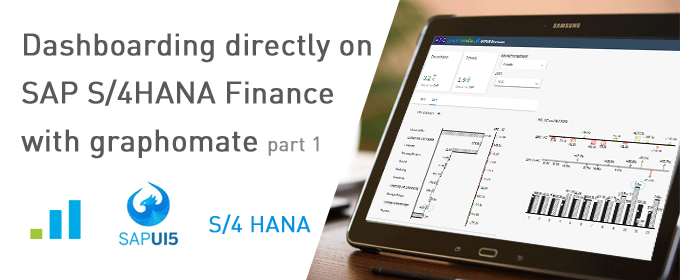Dashboarding directly on SAP S/4HANA Finance with graphomate (I/II)

In many companies SAP S/4HANA is currently being dealt with – quite intensively. Although SAP has postponed the end of “normal” maintenance for SAP Business Suite 7 from 2025 to the end of 2027, there is still a lot of work ahead. Not only should the company’s own business processes be analyzed in detail and adapted if necessary before switching to S/4HANA, but S/4HANA also brings new possibilities for reporting that need to be addressed.
For example, S/4’s underlying HANA as an in-memory database offers the possibility of executing OLTP and OLAP processes in one system. Or to put it another way: We can run OLAP analyses directly on the document tables in real-time now.
And that’s not all. With S/4HANA Finance, SAP is turning Controlling (CO) and Finance (FI) inside out. Two – document – areas become one. I still remember well how I was allowed to reconcile controlling and finance values on long evenings in my first life. That’s history: all financial and controlling data is now combined in one single table in S/4HANA – the Universal Journal a.k.a ACDOCA. Which stands for Accounting Documents Actuals and has an estimated 350+ columns waiting to be analyzed.
Wouldn’t that be a great data source for operational reporting? After all, HANA offers OLAP analytics out-of-the-box. The only thing missing is a visual analysis interface. This is where we at graphomate come into play. We wanted to build an IBCS-compliant dashboard based on controlling data of the ACDOCA – only with graphomate components, without further BI tools, solely SAPUI5-based.
Consequently, there are no expensive user licenses …
Together with our colleague Robert Lippmann from our partner ASC – Business & IT Consulting, who thankfully gave us access to an S/4 system, we built this dashboard with graphomate charts and graphomate matrix supplemented by standard Fiori components:
As you can see, it is possible to run analyses directly on the data. Visually, everything is in the style of the IBCS. In the second part of the blog post, you will learn more about the technical background and the stumbling blocks that need to be avoided.
Stay tuned,
Lars

This file is licenced under the Creative Commons-Licence.
